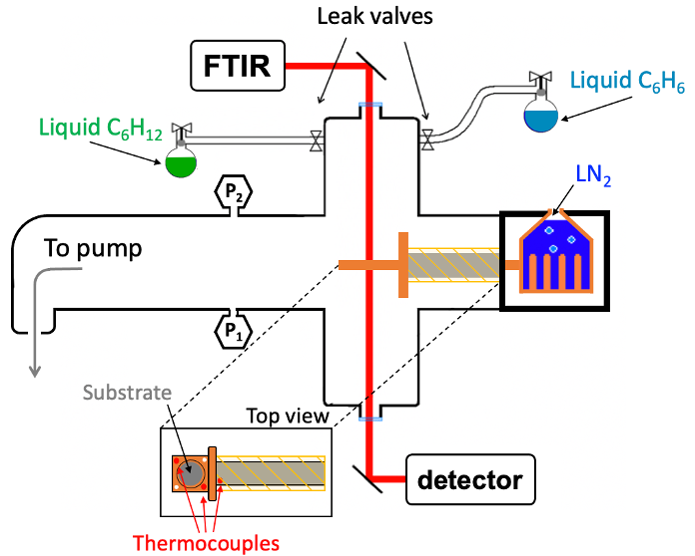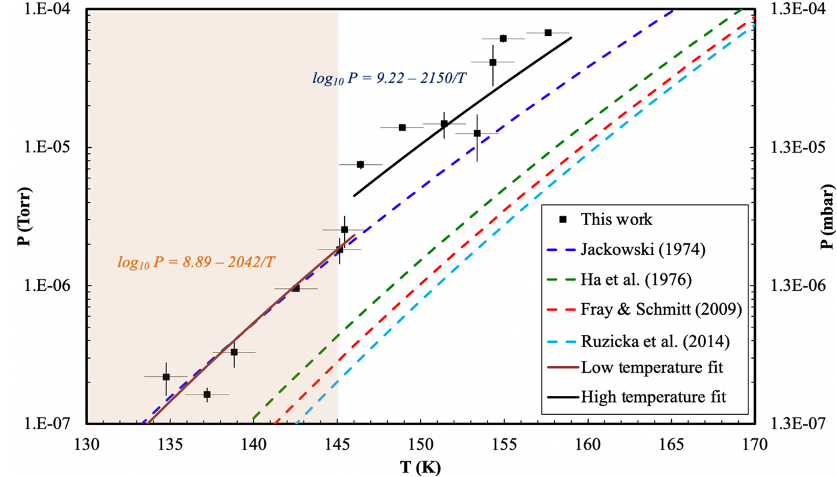- 1NASA Ames Research Center, Moffett Field, CA, USA (david.f.dubois@nasa.gov)
- 2Bay Area Environmental Research Institute, Moffett Field, CA, USA
- 3Southwest Research Institute, Boulder, CO, USA
- 4LESIA, Observatoire de Paris, Université PSL, CNRS, Sorbonne Université, Université de Paris, Meudon, France
1. Introduction
Following the northern spring equinox in August 2009, Titan’s global atmospheric circulation reversed within the next two years. This event increased the mixing ratios of benzene (C6H6) and other species at the South pole. Simultaneously, a strong cooling with temperatures dropping below 120 K favored the condensation of organic hydrocarbon molecules at unusually high altitudes (>250 km). The Cassini Composite Infrared Spectrometer (CIRS) detected for the first time an IR spectral signature consistent with the presence of C6H6 ice in the South polar region at these high altitudes [1]. Previous laboratory data used for the interpretation of CIRS data [2], however, was insufficient to allow models to reproduce the formation of this high-altitude cloud system.
2. Methods
We have combined laboratory [3], modeling [4] and observational [1] efforts to investigate the chemical and microphysical processes leading to the formation of the cloud system that formed at unusually high altitude (> 250 km) over Titan’s South pole after the northern spring equinox. We present here a study focused on the formation of C6H6 ice clouds at 87ºS. We have experimentally measured, for the first time, the equilibrium vapor pressure of pure C6H6at low temperatures (134-158 K) representative of Titan’s atmosphere using the NASA Ames Atmospheric Chemistry Laboratory [3,5] (ACL). The ACL (Figure 1) has enabled us to monitor the condensation of C6H6 in the IR and determine the nucleation supersaturation and equilibrium vapor pressure of pure C6H6 at Titan-relevant temperatures (134–158 K).

Figure 1. Schematic diagram (not to scale) of the ACL experimental apparatus used for benzene ice condensation and growth studies (adapted from [3]), including the capability for cyclohexane calibration measurements. Pressure is measured with a capacitance manometer (P1) and an ion gauge (P2). The inset shows a top view of the sample holder with the positions of the two K-type thermocouple gauges (red dots) used for temperature measurements. The ice sample forms on either or both sides of the silicon substrate (grey), which is in the path of the IR beam. Infrared transmission spectra are collected with an external DTGS detector (adapted from Dubois et al. 2021).
We have used our benzene experimental vapor pressure to re-analyze CIRS observational data from May 2013 covering the 68°S to 87°S latitudes and derive benzene volume mixing ratios. The experimental data along with the temperature profiles and C6H6 mixing ratios derived from CIRS observational data at 87ºS were then used as input parameters in the coupled microphysics radiative transfer Community Aerosol and Radiation Model for Atmospheres (CARMA) to simulate C6H6 ice cloud particle size distribution, gas volume mixing ratios, gas relative humidity and cloud altitudes. CARMA simulates the microphysical evolution of aerosol particles in a column of atmosphere. Benzene cloud particle formation and growth is controlled by the vapor pressure of C6H6. All particles are transported vertically through sedimentation, eddy diffusion, and a vertical wind simulating Titan’s Hadley cell. We simulated the southern polar atmosphere in CARMA by initializing the model with a temperature/pressure profile from CIRS data at 87ºS.
3. Results & Conclusions
Figure 2 shows the first experimental measurements of benzene vapor pressure at Titan-relevant temperatures compared to extrapolations from higher temperatures [2,6-8]. Our vapor pressures can be fitted with two slopes (T < 146 K and T > 146 K) that we have parameterized. Because the temperature regime in Titan’s atmosphere at the South pole where the benzene cloud formed is less than 146 K, we used our low temperature experimental parameterization in the CIRS re-analysis and with CARMA. The CIRS re-analysis have resulted in benzene condensation occurring at lower altitudes in the stratosphere than previously thought [5]. The CARMA simulations at 87ºS have helped us constrain C6H6ice particle size distribution, gas volume mixing ratios, gas relative humidity and cloud altitudes down to lower altitudes that are not accessible with CIRS observations. The simulations predict greater C6H6 gas mixing ratios below the condensation level than with previous vapor pressure extrapolations, resulting in more C6H6 being available per CCN to condense at stratospheric levels (< 250 km) and hence a growth in size distribution, in particular between 125 km and 50 km. At 87ºS, as observed with the CIRS data re-analysis, the CARMA model predicts benzene condensation occurring deeper in the stratosphere. From the re-analysis of Cassini CIRS observations at latitudes spanning from 68ºS to 87ºS, we also inferred that the vortex polar boundary in 2013 resided between 78ºS and 83ºS. From 83ºS to 87ºS, the cloud top would be located between 246-256 km, and from 68ºS to 78ºS it would be located between 90 and 110 km.

Figure 2. Experimental vapor pressure measurements of C6H6 ice (black) with associated temperature and pressure uncertainties, along with two new vapor pressure parameterizations fitted to the experimental measurements following the colder (134-146 K – brown) and warmer (146-158 K – black) temperature ranges. For comparison, the extrapolations from higher temperature measurements [2, 6-8] (represented as dashed lines) from J74 (blue), H76 (green), F&S09 (red) and Růžička et al. (2014, cyan) parameterizations are also plotted on this figure. Pressures are given in both Torr (experimental measurement unit) and mbar (for comparison to observational data). The orange shaded area represents the temperature range relevant to Titan’s stratosphere in the South pole in May 2013, where benzene ice clouds were detected, i.e., < 145 K (reproduced from Dubois et al. 2021).
Acknowledgements
Funding for this project was provided through NASA SMD CDAP.
References
[1] Vinatier, S. et al., Icarus, 310, 89–104, 2018.[2] Fray & Schmitt, Planet. Space Sci., 57, 2053–2080, 2009.
[3] Iraci, L. T. et al. Icarus, 210, 985–991.
[4] Barth, E. L. Planet. Space Sci., 137, 20–31, 2017.
[5] Dubois et al., PSJ, 2021 (in press).
[6] Ha, H. et al., J. Chem. Soc., 72, 1051–1057, 1976.
[7] Jackowski, A. W., J. Chem. Therm., 6, 49–52, 1974.
[8] Růžička, K. et al., J. Chem. Therm., 68, 40–47, 2014.
How to cite: Dubois, D., Iraci, L., Barth, E., Vinatier, S., Salama, F., and Sciamma-O'Brien, E.: Multidisciplinary investigation of benzene (C6H6) condensation in Titan’s South polar cloud system, Europlanet Science Congress 2021, online, 13–24 Sep 2021, EPSC2021-566, https://doi.org/10.5194/epsc2021-566, 2021.

